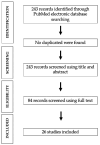Roles and Applications of Circulating Tumor-Derived RNAs in Sarcoma Patients: A Systematic Review
- PMID: 39519267
- PMCID: PMC11546317
- DOI: 10.3390/ijms252111715
Roles and Applications of Circulating Tumor-Derived RNAs in Sarcoma Patients: A Systematic Review
Abstract
Sarcomas are a heterogeneous group of malignancies with a high mortality rate. Detection of circulating tumor-derived material, such as circulating RNA in the peripheral blood of patients, has shown to be useful in diagnosis, prediction of prognosis and disease monitoring in several malignancies. This systematic review aims to probe the existing methods for detecting circulating tumor-derived RNAs from patients affected by sarcoma and their possible clinical application. A systematic review of the literature indexed in PubMed was performed. Each article had to analyze circulating RNA in human specimens obtained from liquid biopsies of patients affected by sarcoma. A total of 26 articles were included. We evaluated 1381 patients; 72% were affected by bone sarcoma and 28% by soft tissue sarcoma. By PCR-based methods, all the studies investigated circulating tumor RNA, mostly in the peripheral blood. Nearly half of the authors investigated the tumor expression and/or release of miRNA (42%). Several authors pointed out that circulating tumor-derived RNA has proven to have potential application in a clinical setting for sarcomas. To the best of our knowledge, this is the first review in the literature to attempt to put together data specifically on ctRNA in patients affected by sarcoma.
Keywords: Ewing sarcoma; STS; circulating tumor RNA; circulating tumor nucleic acids; ctNAs; ctRNA; liquid biopsy; osteosarcoma; sarcoma; soft tissue sarcoma.
Conflict of interest statement
The authors declare no conflicts of interest.
References
-
- Surveillance, Epidemiology, and End Results (SEER) Program SEER*Stat Database: Incidence—SEER 9 Regs Research Data, Nov 2010 Sub (1973–2008)—Linked To County Attributes—Total U.S., 1969–2009 Counties, National Cancer Institute, DCCPS, Surveillance Research Program, Cancer Statistics Branch, released April 2011, Based on the November 2010 Submission. [(accessed on 21 October 2024)]; Available online: www.seer.cancer.gov.
-
- Cancer.gov [(accessed on 21 October 2024)]; Available online: https://www.cancer.gov/types/soft-tissue-sarcoma/hp.
Publication types
MeSH terms
Substances
LinkOut - more resources
Full Text Sources
Medical


